This is the first time I have tried painting an abstract. I found it quite hard to do and need to learn more about how to go about it. I used acrylic paint with some impasto medium to give it some body.
I'm reasonably happy with it. I enjoyed layering various colours and creating several small areas with their own atmosphere.
Monday, 30 November 2009
Monday, 2 November 2009
My Garden




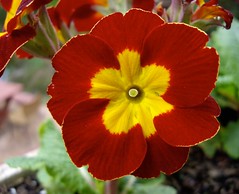
These are some photos of my garden in the spring. I love to wander around and takes photos in the different seasons. My front path has one of my favourite native plants - Prostanthera Ovalifolia which is purple. Alpine Phlox are the ground covers. Azaleas have been blooming beside my house for nearly 30 years. Then there is a camellia, pansy, rhododendron, polyanthus and euphorbia.
Friday, 30 October 2009
My dogs

It is a long time since I have put an image of my gorgeous little dogs on my blog. They have just had their hair cut and are in their favourite place on the lounge. Daisy is on the left and she is almost certainly the daughter of Rosie. Uncertainty remains as they came from the RSPCA since they were found abandoned in the street seven years ago. They had been abused and were not housetrained but now they seem pretty relaxed. Lhasa Apsos are supposed to have very long hair since they are from Tibet but I like to keep it shorter, especially as summer is beginning.
Labels:
Dogs,
Lhasa Apsos
Monday, 26 October 2009
Drawing & Collage
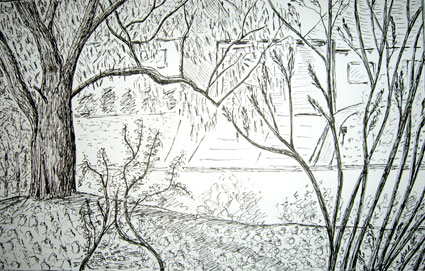
This was a pen and ink sketch I did from my front window looking from my garden across the street to other houses. Most of my garden is native Australian trees and other plants and is covered in tan bark as a mulch to retain moisture. This is especially important with summers getting hotter and drier.
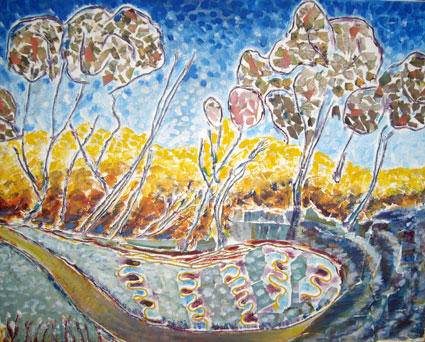
This was one of the final paintings done in my painting class on Wednesdays with Michael Winters. It was finally warm enough to go outside and draw some trees and a pond. Then we used string, torn newspaper and card to glue onto the canvas to recreate the picture. When this was dry some acrylic paint was added to complete the picture. It was harder to do than it looks - really interesting and challenging.
Sunday, 25 October 2009
Botanical Painting
 I have not worked in watercolour for many years and found a lot of the paints dried out. But I couldn't resist responding to an ad in the newspaper for a weekend in Botanical Painting held quite close to where I live. The old Tuggeranong Homestead had a beautiful garden and I picked a couple of hellebore flowers and a spig of lavender to work with. Generally I was quite happy with my first effort painting such detail, especially as I have been doing so many big acrylic paintings.
I have not worked in watercolour for many years and found a lot of the paints dried out. But I couldn't resist responding to an ad in the newspaper for a weekend in Botanical Painting held quite close to where I live. The old Tuggeranong Homestead had a beautiful garden and I picked a couple of hellebore flowers and a spig of lavender to work with. Generally I was quite happy with my first effort painting such detail, especially as I have been doing so many big acrylic paintings.
Saturday, 10 October 2009
More paintings
This is a painting of a photo I made in Lawn Hill National Park on the border of Queensland and the Northern Territory last May. We had climbed up a rocky track to a high point looking over the gorge. I only used Ultramarine Blue and Burnt Sienna, learning to paint with a limited palette in Michael Winter's class. Moving the brush a lot enhanced the texture on the trunk.
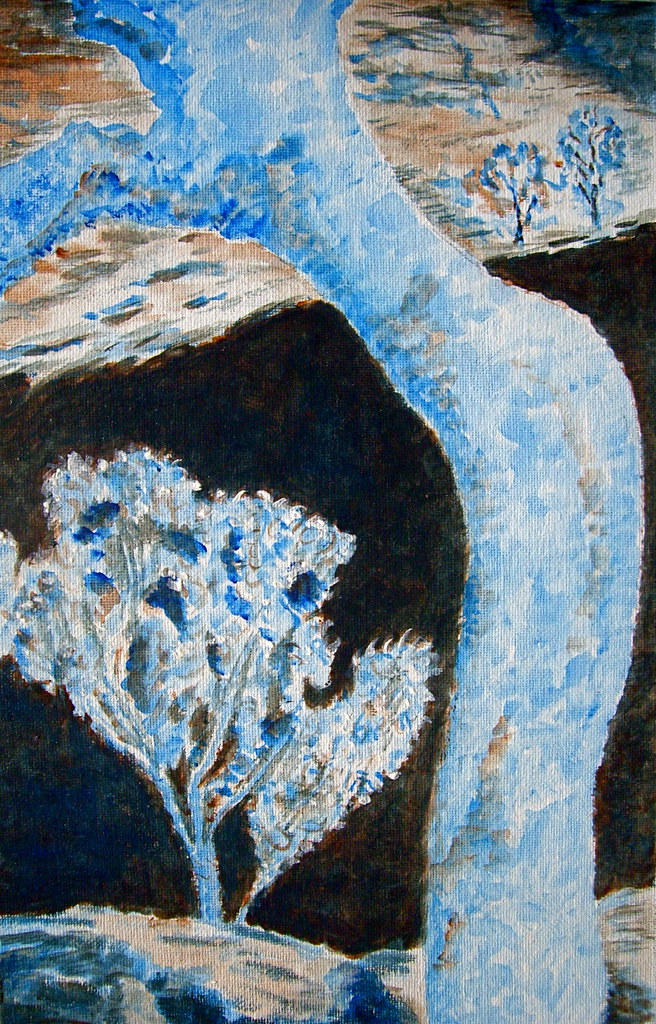
This is another quite small painting using the same limited palette. The tones were painted on roughly first and the details added later. I walk in these gardens most weeks and take lots of photos to use in paintings. It's amazing how such dark tones can be made without using black which tends to deaden paintings.


This is another quite small painting using the same limited palette. The tones were painted on roughly first and the details added later. I walk in these gardens most weeks and take lots of photos to use in paintings. It's amazing how such dark tones can be made without using black which tends to deaden paintings.

Wednesday, 16 September 2009
Linocuts and Acrylic Painting
 I painted this tree using sand glued onto the trunk thereby creating texture when acrylic paint was added. The background was painted using the acrylics like watercolour so showing the contrast with the big tree. Smooth skinned shoots strangely come out of the trunk.
I painted this tree using sand glued onto the trunk thereby creating texture when acrylic paint was added. The background was painted using the acrylics like watercolour so showing the contrast with the big tree. Smooth skinned shoots strangely come out of the trunk.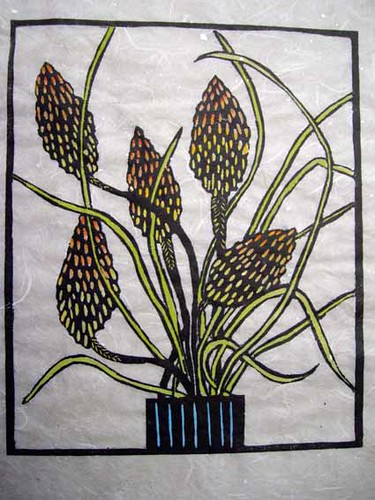
I drew these Red Hot Pokers in a vase from life. Then I cut a lino block and printed the image on light textured Japanese paper. It was then hand coloured with gouache.

I drew these gum blossoms with some nuts and then cut a lino block. After printing on light Japanese paper, it was hand coloured somewhat like Margaret Preston's work.
Saturday, 22 August 2009
More paintings
This is another painting from the Looking at Landscape course I am doing. We are now onto texture as well as tone so the paint is put on fairly thickly. This picture of the corner of my back garden was begun by painting the whole canvas red so that this shows through and gives some dynamic to the bright colours.
This painting was done for an assignment and is in response to an historic event or news item. A few weeks ago it was both - celebrating the 1969 moon landing. The collage was made from a newspaper supplement of the old newspapers from 40 years ago.

This painting was done for an assignment and is in response to an historic event or news item. A few weeks ago it was both - celebrating the 1969 moon landing. The collage was made from a newspaper supplement of the old newspapers from 40 years ago.

Sunday, 2 August 2009
Learning to Paint Landscapes with Acrylics
This semester I have joined Wednesday morning classes with Michael Winters, a well known Canberra artist and printmaker. We have been working on tonal studies with a limited palette and trying to blend the edges of shapes and lines in a similar way to the early Australian painters from the Tonalist Movement 1915-1950. Two significant painters were Max Meldrum and Clarice Beckett. A recent exhibition I saw is called "Misty Moderns". At first only burnt umber and white could be used, then Ultramarine Blue was added to the palette. Photos used for paintings were reduced to black and white to emphasise the tones since colour is so dominant to the eye.
At first only burnt umber and white could be used, then Ultramarine Blue was added to the palette. Photos used for paintings were reduced to black and white to emphasise the tones since colour is so dominant to the eye.

My front garden path and the statue by my pond featured in many of these paintings.

Yellow was then added to the palette extending the range of colours as well as tones.
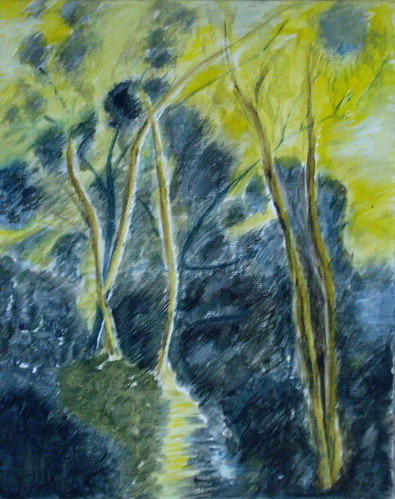
Finally Cadmium Red was added to the palette. Black was never used as it flattens colours.

 At first only burnt umber and white could be used, then Ultramarine Blue was added to the palette. Photos used for paintings were reduced to black and white to emphasise the tones since colour is so dominant to the eye.
At first only burnt umber and white could be used, then Ultramarine Blue was added to the palette. Photos used for paintings were reduced to black and white to emphasise the tones since colour is so dominant to the eye.
My front garden path and the statue by my pond featured in many of these paintings.

Yellow was then added to the palette extending the range of colours as well as tones.

Finally Cadmium Red was added to the palette. Black was never used as it flattens colours.

This was an experimental picture using a highly textured background.
Click on the picture to see more details of the method.
Click on the picture to see more details of the method.
Monday, 13 July 2009
Knitting as Graffiti & Another Painting

 I still visit galleries quite a lot as there are so many in Canberra to see. Yesterday I saw something very unusual - it is using Knitting as Graffiti and here are a couple of photos I took at the Australian National Gallery where it was on display in conjunction with the Soft Sculpture Exhibition. People from everywhere, including a couple of my friends, have knitted scarf like pieces or used unfinished kntting projects, that are wrapped around poles and sculptures in the gallery garden. They are so colourful and fun - and unlike other graffiti can be removed easily without defacing anything. Apparently this is a street art phenomenon spreading around the world.
I still visit galleries quite a lot as there are so many in Canberra to see. Yesterday I saw something very unusual - it is using Knitting as Graffiti and here are a couple of photos I took at the Australian National Gallery where it was on display in conjunction with the Soft Sculpture Exhibition. People from everywhere, including a couple of my friends, have knitted scarf like pieces or used unfinished kntting projects, that are wrapped around poles and sculptures in the gallery garden. They are so colourful and fun - and unlike other graffiti can be removed easily without defacing anything. Apparently this is a street art phenomenon spreading around the world. I was going to paint another still life using a blue background rather than the red one I had done earlier, but got sidetracked into a design with lines, shapes and colours as that is what I really like doing. It started out as leaf shapes on the diagonal - a lot of fun.
I was going to paint another still life using a blue background rather than the red one I had done earlier, but got sidetracked into a design with lines, shapes and colours as that is what I really like doing. It started out as leaf shapes on the diagonal - a lot of fun.I've been spending more time on the computer than painting in the last few weeks but have just joined a Michael Winter's painting class called "Looking at Landscape" so will be going out to Strathnairn Art Centre where it is held every Wednesday Morning for the next 15 weeks. I must get outside and do my homework of a tonal sketch in pencil of part of my garden. A bit cold out there in July - ugh! Only 12 degrees today.
Sunday, 31 May 2009
Recent Acrylic Paintings


These two paintings were done while visiting my artist friend Chris Hobel on the Sunshine Coast in Queensland. Her blog is in a link on this page. As I had no art materials with me I painted sheets of cartridge paper with gesso the night before, and they became quite suitable for painting.
"Desert Town" became an exercise in colour and shape after a saw a photo of a similar place. I have also been to such places myself and I had fun using the memories to invent this picture. "Poppy fields" was another composite from looking at several fields of poppies.
I had a lot of fun doing these as I hadn't painted anything for quite some time and I want to get back into it as I am going to study an acrylic painting unit in the Tapestry Diploma I am doing next semester.
 Last week at my U3A art group we tried an easy but different picture. I think the idea came from Michael Winters, a local well-known artist who runs classes. Firstly the canvas was stained with red (can be several different reds), then willow charcoal was used to draw a still life. The shadows were filled in darkly, then acrylic paint was used to complete the picture within the charcoal lines. Some areas were left blank and some just allowed part of the red through. I quite like the strong shapes and colours that result. Maybe this week I'll try a blue background.
Last week at my U3A art group we tried an easy but different picture. I think the idea came from Michael Winters, a local well-known artist who runs classes. Firstly the canvas was stained with red (can be several different reds), then willow charcoal was used to draw a still life. The shadows were filled in darkly, then acrylic paint was used to complete the picture within the charcoal lines. Some areas were left blank and some just allowed part of the red through. I quite like the strong shapes and colours that result. Maybe this week I'll try a blue background.
Friday, 22 May 2009
Design from photographs
 This is the first more complex design I have made from photographs using Photoshop. I have used some of the photos from the National Folk Festival from my last post as well as others. I am a very amateur Photoshop worker but have learnt a few things quite well from doing this design.
This is the first more complex design I have made from photographs using Photoshop. I have used some of the photos from the National Folk Festival from my last post as well as others. I am a very amateur Photoshop worker but have learnt a few things quite well from doing this design.The idea was to do a design for a tapestry weaving but it is really too complex unless the weaving was huge. My teacher suggested it be divided into four different ones.
Thursday, 16 April 2009
National Folk Festival






I had another wonderful four days at Easter at the National Folk Festival in Canberra, my home city. I drove the 30km to the other side of the city and when I had my wristband ticket scanned and entered the gates I felt as though I was in another world - folkies of all ages and from every State in Australia and overseas. Over 10,000 came every day. There were hundreds of musicians and dancers, instrument makers, street performers, stalls selling food and everything else, and people just having fun. And the festival always wins the award for the best recycling - hardly any rubbish is seen anywhere. I tried taking a few pics inside the venues - without flash - some turned out quite well, others were more 'artistic'.
The belly dancers were great and performed on a stage in the Piazza where you could sit around, eat & drink and watch dancing. Sometimes you could join in and learn too. There were lots of workshops. The local belly dancing group had its own band and here is a photo of two drummers - Richard & Frances.
One picture shows Anita George singing and playing guitar. A South American band called Inca Marka had this amazing guy playing 2 instruments at once. And Michael Kennedy, from Castlemaine, Victoria was a fantastic song writer and singer. I heard him several times.
Wednesday, 8 April 2009
Collagraphs by Hand

 I made a design from a picture in a European city to show the urban environment with lots of different shapes and textures . But as I no longer had access to an etching press these prints show my attempts at making collagraphs by hand, that is, without a press. The plates were made entirely from cardboard, paper, masking tape and tissue paper. One is printed on yellow Japanese paper which is quite absorbent, the other on thicker Japanese paper which was dampened to make it softer.
I made a design from a picture in a European city to show the urban environment with lots of different shapes and textures . But as I no longer had access to an etching press these prints show my attempts at making collagraphs by hand, that is, without a press. The plates were made entirely from cardboard, paper, masking tape and tissue paper. One is printed on yellow Japanese paper which is quite absorbent, the other on thicker Japanese paper which was dampened to make it softer.It was much harder applying ink, wiping off ink where I had applied varnish to make lighter tones and rubbing on the back by hand when it wasn't possible to see exactly what you were rubbing. Of course trying to print with two colours on the same plate was also quite hard as it wasn't possible to blend the colours in the design. Nevertheless there are some interesting shapes and textures and it was fun spending an autumn day working on the prints.
Saturday, 4 April 2009
Collagraphs
 I have just spent two Saturdays learning how to make a collagraph plate and prints from it. A collagraph print is a collage printmaking technique and a form of Intaglio printing. The collagraph plate is printed the same way as etchings, but also include the basic principle of relief printing.
I have just spent two Saturdays learning how to make a collagraph plate and prints from it. A collagraph print is a collage printmaking technique and a form of Intaglio printing. The collagraph plate is printed the same way as etchings, but also include the basic principle of relief printing. Five of us went to Marianne's studio at Araluen (nearly 2 hours drive from home) where we had access to a good teacher and an etching press. My subject was "Abstract" - I made a background plate (A4 size) which I painted in yellow and the main plate which I painted cobalt blue - this of course became green when it was printed over the yellow. The red was added as hand colouring later. It was fun glueing all sorts of things like string, mesh, cardboard, tissue paper and lace to a base of matboard to make the plate. Waterproofing was thoroughly done with gesso and a coat of shellac. The plate cannot be very high as it has to fit through the press, and the lower as well as the higher part prints. Great variation in texture can be obtained but it's not easy working out the amount of ink (oil based) to leave on the plate for good printing. Tones can be adjusted by the strenth of the ink and the nature of the materials. Varnish on the parts one wants lighter makes it easier to reduce the ink there before printing. A form of registration is essential when printing more than one plate to make a print - hard work but very satisfying. I now have to print another plate at home without a press, so it will be interesting how it looks when completely hand done.
Saturday, 7 March 2009
Summer at home in my garden

 February has been very hot and dry and staying inside in the air conditioning has been a major activity - plenty to do with assignments for my course. But the sulphur crested
February has been very hot and dry and staying inside in the air conditioning has been a major activity - plenty to do with assignments for my course. But the sulphur crested  white cockatoos have been busy this time of year eating the berries from my pistache tree and effectively pruning leaves and branches and dropping them everywhere.
white cockatoos have been busy this time of year eating the berries from my pistache tree and effectively pruning leaves and branches and dropping them everywhere.It's so dry some of the Virginia Creeper leaves are changing colour already. My dogs, Rosie and Daisy need a haircut but enjoy being on the back deck and watching what I'm doing. I've been having fun p
 hotographing the centre of some of the flowers in my garden. They have potential for tapestry designs. Amongst some of the greenery the Snake Woman sculpture rises out to survey the scene.
hotographing the centre of some of the flowers in my garden. They have potential for tapestry designs. Amongst some of the greenery the Snake Woman sculpture rises out to survey the scene.At last in March temperatures are finally under 30C and the weather is fantastic, if only it would rain. All the rain has been in northern Australia with the monsoon flooding, the worst for many years. And everyone has heard of the shocking bushfires in Victoria where over 200 people have died and thousands of homes lost. Australia sure is a land of extremes.
Tuesday, 3 February 2009
Tapestry Camp
I have just returned home from a 5 day camp at Hall's Gap in Western Victoria where some students doing the Diploma of Tapestry at SW TAFE by correspondence meet once a year. It is 1,000km and 2 days drive from my home but worth it to meet with the tutors and other students. It is important to see what others are doing as well as get an introduction to this year's units. Betty Woolf is holding up her tapestry of tulips which I saw her designing 2 years ago. Pat Scholz is showing her fingers working on a small tapestry with a blue background. And the last picture shows a bluff of the Grampian Mountains taken from the verandah at Norval where we were staying. Luckily the building was airconditioned as heatweave conditions up to 45 degrees Celsius were being experienced.
 This year I am studying units in Painting, Printmaking, Photography and History of Tapestry. There will be lots of assignments to complete but they are so interesting and usually a lot of fun.
This year I am studying units in Painting, Printmaking, Photography and History of Tapestry. There will be lots of assignments to complete but they are so interesting and usually a lot of fun.

Thursday, 22 January 2009
Japanese Woodblock Printing


Last week I went to the Summer Art Experience run by the Artists Society of Canberra and for 5 days immersed myself in learning the Japanese way of creating woodblocks and printing them. It was a fantastic course and the two images here show my results. Marianne Courtenay was our tutor - her website is in the Links on this page. I have done courses in lino printing with her before and all have been excellent. The mountain view was done as a reduction woodblock print, whereas the leaves print was made with two woodblocks superimposed, one cut down to make the background and the other raised. As we were having a heatwave when making these prints and had the air conditioning on, it was quite challenging to keep the paper damp. We needed the humidity of Japan. I really liked using gouache as the paint medium rather than the oil based inks for lino which is much messier in cleanup. The Japanese method of registration was very interesting as we cut a Kento block to do this.
Subscribe to:
Posts (Atom)



